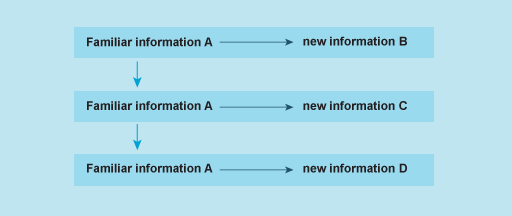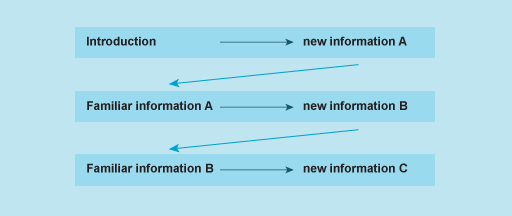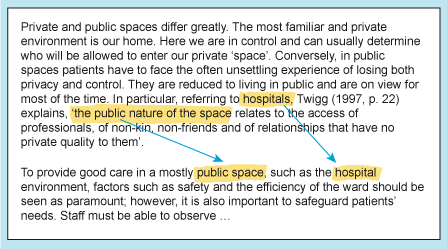2.1 Linking paragraphs
One way to lead readers into the topic introduced in a new paragraph is to use the first sentence to mention something the reader already knows something about. This is usually a person, a concept or an event that has already been mentioned in the previous paragraph (Figure 2). This familiar information is used to introduce new information.
For example, the last two sentences of Fred’s second paragraph introduce the concepts of ‘hospitals’ and ‘public space’. These will be perceived as familiar information by readers when they are reused at the beginning of the following paragraph (Figure 3).
A similar way to help readers follow a writer’s reasoning is to mention the same familiar information in the topic sentences of two or more paragraphs. Therefore the topic sentence of each paragraph starts by mentioning the same familiar information. This is usually done when the writer needs two paragraphs to deal with the same topic. In this case, the writer can break each topic into two or more subtopics and deal with each in a separate paragraph (Figure 4).

This is the approach Fred takes in paragraphs 4, 5 and 6. Each paragraph starts with a topic sentence that introduces an aspect of care in residential homes:
[P4] In the residential care setting too, it is important that staff recognise the differences between public and private spaces. …
[P5] In a good residential home, the staff will acknowledge the residents’ wishes to control their private space. …
[P6] The story is very different in poorly run residential homes. …
Activity 4
Reread the last two paragraphs of Fred’s essay (reproduced below). Which of the two methods listed below does Fred use to link these paragraphs to each other? Make some notes in the box before comparing them with the answer.
- The first sentence of a new paragraph mentions something the reader already knows something about.
- The topic sentences of two or more paragraphs mention the same familiar information.
It would seem that those who receive care at home should be in a stronger position to maintain their autonomy, but even here carers must be aware that their behaviour can change this situation considerably. Carers’ sensitivity to their clients’ private space and needs can therefore make an enormous difference. This is because people in need of care have less choice over who comes into their homes and what carers do once inside. Even areas such as bedrooms and bathrooms can be ‘under threat’. Though the reasons for this invasion of privacy may be fully understood and accepted, it is still difficult to lose control of the home environment. For example, when she was discharged from hospital, Esther Hurdle felt that she had limited control over her day-to-day life as her carer was more concerned with her own routines than with Esther’s needs and capabilities (Peace, 2005, p. 73). Esther felt, as suggested by Twigg (1997, p. 22), that ‘being and feeling at home means managing as you wish’ and not according to some professional ‘mode of coping’.
A good home carer will always respect the wishes of the client and show them that their right to privacy is valued. A person’s home is rightly regarded as the last bastion of privacy and safety. It is all too easy to feel that any remaining control over one’s own life is being taken away, if home care is not dealt with sensitively. Therefore, as Bell (1993, p. 40) advises, carers should treat the home care environment as their patients’ private space.
Answer
Fred uses the second method, as the topic sentences of both paragraph 7 and paragraph 8 mention care at home.
[P7] It would seem that those who receive care at home should be in a stronger position to maintain their autonomy, but even here carers must be aware that their behaviour can change this situation considerably …
[P8] A good home carer will always respect the wishes of the client and show them that their right to privacy is valued …


